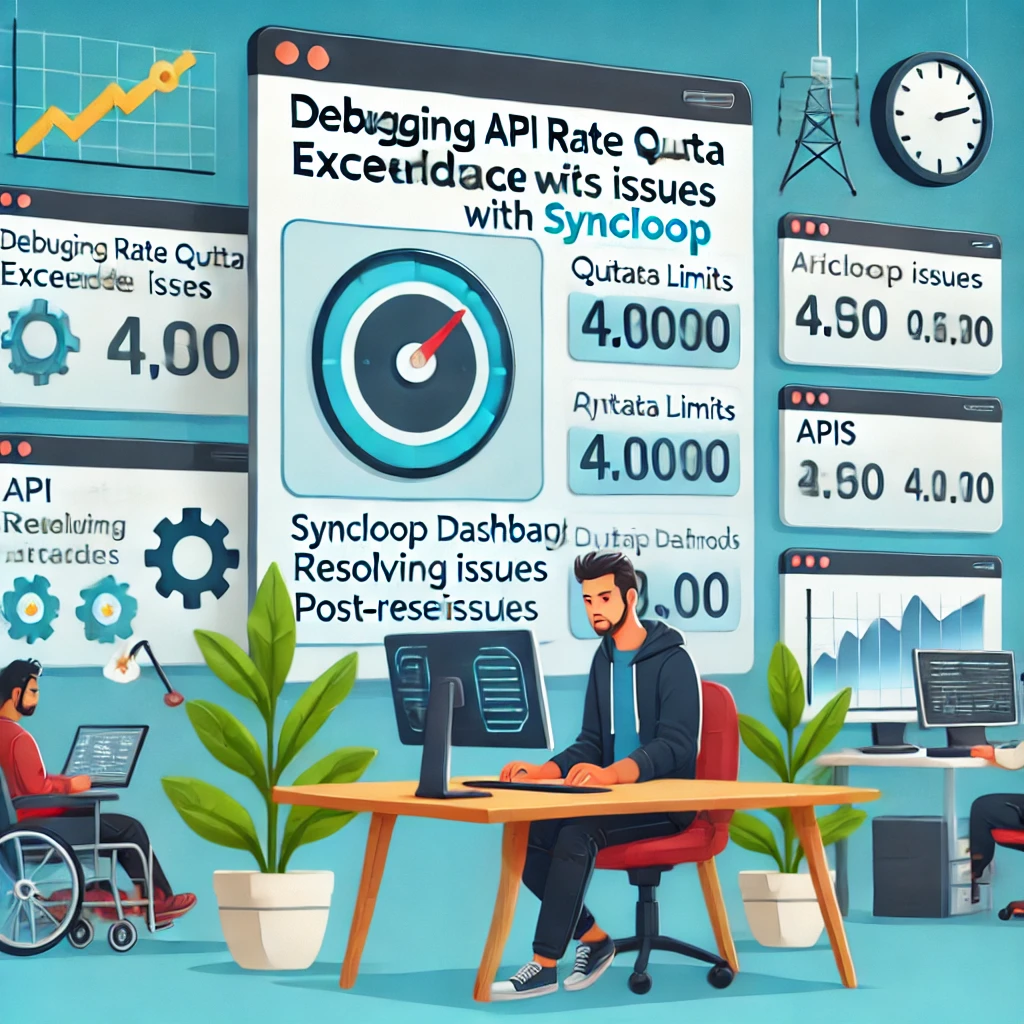Debugging API Rate Quota Exceedance Issues with Syncloop

Syncloop provides tools for monitoring, analyzing, and resolving rate quota issues effectively. This blog explores common causes of quota exceedance, how Syncloop helps in debugging, and best practices for maintaining API performance under quota constraints.
Importance of Managing API Rate Quotas
API rate quotas are critical for:
- Protecting System Resources: Preventing overuse that can lead to performance degradation.
- Ensuring Fair Access: Distributing resources equitably among users or clients.
- Maintaining SLA Compliance: Meeting agreed-upon service levels without disruptions.
- Controlling Costs: Avoiding unnecessary resource usage that incurs additional costs.
Common Causes of Rate Quota Exceedance
- Unexpected Traffic Spikes Sudden increases in API requests due to high user activity or bot attacks.
- Inefficient API Usage Redundant or repetitive calls leading to higher-than-expected request volumes.
- Misconfigured Quotas Incorrect rate limits that fail to align with actual usage patterns.
- Integration Errors Third-party integrations making excessive or unauthorized API calls.
- Lack of Caching Failure to cache responses for frequently requested data, resulting in unnecessary API calls.
How Syncloop Helps Debug Rate Quota Issues
Syncloop provides a comprehensive set of tools for debugging rate quota issues:
- Real-Time Monitoring Track API usage and identify when quotas are exceeded.
- Detailed Logs Access request logs to pinpoint clients or endpoints causing excessive traffic.
- Traffic Analytics Analyze patterns and trends in API usage to identify inefficiencies.
- Custom Alerts Set up notifications for nearing or exceeded rate limits.
- Rate Limit Configuration Adjust quotas dynamically based on usage insights.
- Error Handling Tools Implement workflows to handle quota exceedance gracefully, such as retry mechanisms.
Steps to Debug Rate Quota Issues with Syncloop
Step 1: Monitor Real-Time API Traffic
Enable Syncloop’s real-time monitoring to:
- Visualize API traffic in dashboards.
- Detect traffic surges leading to quota exceedance.
- Identify specific endpoints or clients responsible for high request volumes.
Step 2: Analyze Logs
Use Syncloop’s logging tools to review:
- Request frequencies by client or user.
- Error messages indicating quota exceedance (e.g., 429 Too Many Requests).
- Timing and volume of exceeded requests.
Step 3: Investigate Traffic Patterns
Analyze Syncloop’s traffic analytics to:
- Determine peak usage times.
- Identify patterns of redundant or inefficient calls.
- Spot abnormal activity indicative of bots or misconfigured integrations.
Step 4: Adjust Quotas
Based on insights, configure quotas in Syncloop to:
- Align limits with actual usage trends.
- Set tiered quotas for different client types or usage plans.
- Apply stricter limits to high-traffic endpoints.
Step 5: Implement Caching
Reduce redundant calls by:
- Caching frequently requested data at the client or server level.
- Using Syncloop’s caching tools to serve responses for repeat requests efficiently.
Step 6: Communicate with Clients
Inform API consumers about best practices, such as:
- Optimizing request strategies.
- Respecting retry-after headers in case of rate limits.
- Updating integrations to avoid unnecessary calls.
Step 7: Test and Validate Changes
Simulate high-traffic scenarios in Syncloop’s testing environment to:
- Validate updated rate limits.
- Ensure error handling workflows function correctly.
- Verify that legitimate traffic is unaffected.
Best Practices for Managing API Rate Quotas
- Set Realistic Limits Define quotas based on actual usage patterns and backend capacity.
- Enable Graceful Exceedance Handling Return informative error responses with retry-after headers to guide clients.
- Educate API Consumers Provide clear documentation on rate limits and recommended usage patterns.
- Implement Rate Limiters Use Syncloop’s tools to enforce per-client or per-endpoint rate limits.
- Monitor Continuously Track API usage and adjust quotas proactively to prevent exceedance.
Example Use Case: E-Commerce API
An e-commerce platform uses Syncloop to manage API rate quotas effectively:
- Traffic Monitoring: Track usage spikes during sales events.
- Log Analysis: Identify bots causing excessive traffic to product endpoints.
- Quota Adjustment: Increase limits temporarily for VIP clients during promotions.
- Caching: Cache responses for frequently accessed inventory data.
- Error Handling: Inform clients about retry windows and alternative endpoints.
Benefits of Using Syncloop for Rate Quota Management
- Proactive Issue Detection: Identify and resolve issues before they impact users.
- Enhanced Efficiency: Optimize API usage by eliminating redundant calls.
- Scalability: Adjust quotas dynamically as traffic grows.
- Improved Client Experience: Communicate limits clearly and handle errors gracefully.
- Actionable Insights: Use traffic analytics to refine API design and usage policies.
The Future of API Quota Management
As APIs continue to scale, efficient quota management will be vital to ensure fair usage, prevent overloading, and maintain user satisfaction. Syncloop equips developers with the tools to monitor, analyze, and optimize API quotas, fostering reliable and scalable integrations.
Image Description
A conceptual illustration showcasing Syncloop’s tools for debugging API rate quotas, featuring dashboards for real-time monitoring, traffic analytics, and error resolution workflows. The image highlights scalable and efficient quota management.
Back to Blogs